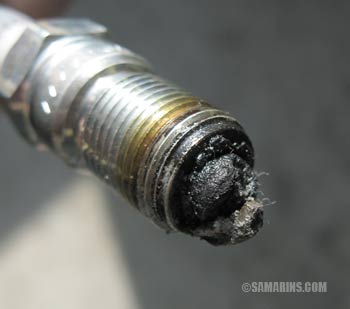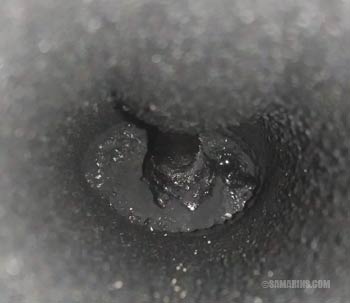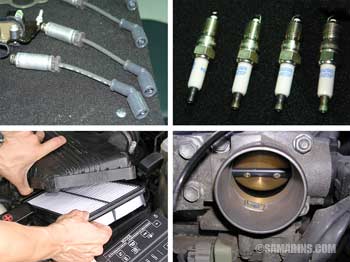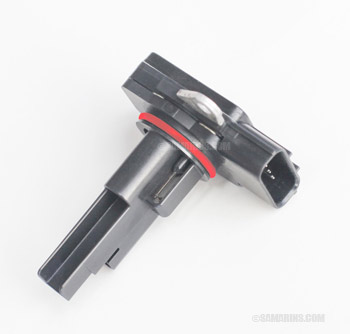P0300-P0308 Cylinder Misfire Detected. Causes, common problems, diagnostic
Updated: July 17, 2021
The code P030X (p0301-P0308) means that the cylinder number X misfires, or there is no combustion in that cylinder. For example, if the cylinder number 1 misfires in a 4-cylinder engine, it will run only on 3 cylinders and will have the code P0301, see the animation.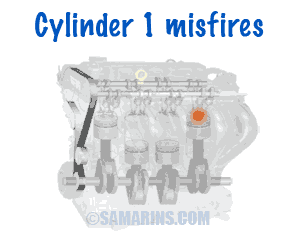 Misfiring engine.
Misfiring engine.Can you drive with the code P0300-P0308? Driving with a misfiring engine can cause more damage. When a cylinder misfires, unburned gasoline can overheat and melt the catalytic converter, which is an expensive part of the emission control system.
Some manufacturers advise not to drive with a misfiring engine; others recommend driving only in a very moderate fashion and having your vehicle checked out as soon as possible. See the vehicle's owner's manual for details.
Symptoms:
A misfiring engine shakes, runs rough (unevenly) and lacks power. Shaking is more noticeable at idle or during acceleration. Some cars misfire only when started cold. The "Check Engine" light on the dash may blink repeatedly or stay on solid. Sometimes, you could also notice a different smell from the exhaust. Watch this video of a misfiring engine.Causes:
The most common cause of the engine misfire and the codes P030X in modern cars is a failed on-plug ignition coil. Other causes include:- Worn-out, cracked or fouled (in the photo) spark plugs.
- Faulty fuel injectors
- Damaged or cracked ignition coil pack.
- Damaged ignition coil primary circuit wires (often chewed by critters).
- Cracked or damaged spark plug cables.
- Carbon build up on valves and injectors (common in engines with Direct Injection)
- Vacuum leaks. A vacuum leak will cause misfire in the cylinder closest to the source of the leak. Examples of vacuum leaks include: leaking intake manifold gasket, broken PCV valve or PCV hose, disconnected vacuum line, cracked vacuum line
- Leaking head gasket
- Low compression in the affected cylinder
- Problems with the valvetrain components
- Bad engine computer (PCM)
What can cause the code P0300 - Random cylinder misfire:
If the code P0300 occurs with other codes, such as, for example, P0171, P0101, P0102, P0420, P0401, the additional codes must be diagnosed first, as the random cylinder misfire often happens as a result of other problems. Possible causes include:- Bad mass airflow sensor.
- Ripped intake air snorkel
- Stuck-open EGR valve or purge valve (solenoid)
- Worn valvetrain components
- Low fuel pressure
- Improperly set valve timing
- Problems with the crankshaft position sensor (CKP) or camshaft position sensor (CMP)
- Clogged catalytic converter
Read more: Catalytic Converter: problems, replacement options.
How misfiring is diagnosed
The cause of misfire of one of the cylinders should be fairly easy to pinpoint if the problem is present at the time of checking. For example, mechanics can identify a faulty on-plug ignition coil by swapping the coils between the cylinders and checking if the misfire moved with the coil or stayed at the same cylinder. The same procedure can be used to identify a bad fuel injector.A quick look at the spark plugs can tell a lot. Signs of arcing on the ignition coil also point to the faulty part. An important step is to check for related service bulletins issued by the car manufacturer. If you don't have access to the factory repair manual, Google 'Make Model Year service bulletin code P0301'. See a few examples below. Basics such as compression, timing and fuel pressure will also need to be checked if no obvious fault is found.
Advertisement
The engine might need to be checked for vacuum leaks. Read more: Vacuum leaks: common sources, symptoms, repairs. The short term fuel trim (STFT) and long term fuel trim (LTFT) need to be checked with a scan tool to see if the air/fuel mixture is not too lean. Often a bad mass air flow sensor causes the engine to run lean causing random misfire. Read more about STFT and LTFT fuel trims here.
Pressure-testing the cooling system might help identify a leaking head gasket that can also cause misfiring. A low coolant level and white smoke can also point to a leaking head gasket.
Valve adjustment may need to be checked, as valves that are out of adjustment can cause misfiring at a cold start, which is, for example, a common issue in some older Honda engines.
If misfiring happens only at idle, the EGR valve and purge valve need to be checked, as either one could be stuck open.
Faulty valve train components such as worn camshaft lobes, collapsed lifters, bad rocker arms or stretched timing chain can also cause the engine to misfire.
Sometimes a broken or damaged tooth at the crankshaft or camshaft sensor gear can be the source of misfiring. This can be checked by monitoring the crankshaft position sensor (CKP) or camshaft position sensor (CMP) signal with an oscilloscope; read more here.
Once the problem is repaired or no longer detected, the misfiring code will clear itself after some driving.
Common problems causing misfire codes P0300-P0308:
Failed on-plug ignition coils are common in many cars, including BMW, Ford, Hyundai, Mazda, Nissan, Toyota, Volkswagen and GM. A failed ignition coil must be replaced; in a 4-cylinder engine it's a fairly simple job. If spark plugs haven't been replaced in a while, it's a good idea to replace all the spark plugs as well. Worn-out spark plugs require higher voltage to produce the spark, which adds strain on ignition coils.Some car manufacturers update ignition coils during later production. If one of the ignition coils has failed and the manufacturer has updated the part, your mechanic may recommend replacing other ignition coils with updated parts as a precaution.
In many modern cars, especially those with Direct Fuel Injection, carbon buildup on intake valves and the injector nozzle can cause misfiring. Some mechanics may recommend cleaning the valves with a special spray or foam (fuel induction service), as it's less expensive and sometimes helps. The more effective option is to clean the intake valves manually. Clogged fuel injectors need to be replaced too. This repair is costly, as it involves more labor; the intake manifold and some other parts will have to be removed. We found a number of YouTube videos on the subject.
Vacuum leaks, as well as a stuck-open EGR valve or purge valve (solenoid) can cause misfiring that mostly happens at idle, but goes away at higher rpms. Read more: Vacuum leaks: common sources, symptoms, repairs.
In some older Honda vehicles misfiring can be caused by valves being out of adjustment. Misfiring could be more noticeable when the engine idles after a cold start. As the valve train components wear, the valve gaps change; to compensate, the valves in many Honda engines need to be adjusted at recommended intervals.
Sometimes, the engine could misfire if during the timing belt or chain replacement, the timing hasn't been set properly. If the problem started after replacing a timing belt or chain, checking the timing is the first thing to do.
In many high-mileage cars, oil leaking into a combustion chamber from worn valve seals and oil rings can foul spark plugs causing misfire; often an engine misfires at idle, but runs better after revving up.
In many older cars, washing the engine compartment or driving through deep puddles can cause the engine to misfire, as water gets into the ignition components and shorts them out. A tune-up with new spark plugs and spark plug cables often fixes the problem. On-plug ignition coils that show cracks or signs of arcing need to be replaced too. In older cars with a distributor ignition, a distributor cap and rotor are also replaced as part of the tune-up.
Examples of related service bulletins
The Honda service bulletin 19-038 for the 2016-2018 Honda Civic with a 1.5L engine describes a problem where codes P0300-P0304 or P0172 (fuel system too rich) or a whirling noise coming from the engine can be caused either by fouled spark plugs or by irregular wear of camshaft lobes. Bulletin 19-032 describes similar problem for the 2017-2018 Honda CR-V.According to the Hyundai service bulletin 20-FL-001H for the 2017 Elantra with a 2.0L engine, codes P0300/P0301/P0302/P0303/P0304 can be caused a faulty ignition coil. The solution per the bulletin is to inspect ignition coils and, if needed, replace with an updated part and update the ECM software.
Toyota issued service bulletin T-SB-0148-19 for the 2017-2019 Highlander HV that mentions replacing the ignition coil and reprogramming the ECM as possible solutions (depending on diagnostics) for the codes P0301-P0306.
Mazda service bulletin 01-014/16 for the 2013-2016 CX-5, 2014-2016 Mazda 3 and Mazda 6 mentions the issue where an ignition coil can fail and cause codes P0301 to P0304. If confirmed, the defective coil must be replaced with an updated part.
How the code P0301 is set
The engine computer or PCM can detect a misfiring cylinder by monitoring the engine crankshaft speed (RPMs). If one of the cylinders misfires, the crankshaft loses momentum and slows down in that moment. If the PCM detects a cylinder to misfire for a predetermined time, it sets the code for the affected cylinder and turns the Check Engine light on.Can a tune-up fix a misfire?
The term 'tune-up' usually means changing spark plugs, replacing the air filter, possibly cleaning the throttle body as well as fuel injectors. In older cars, ignition wires, distributor cap, rotor, and a fuel filter are replaced too. Modern cars require tune-ups less frequently, as they don't have ignition wires and use long-lasting spark plugs.A tune-up is a part of preventative maintenance. To fix the misfire the exact cause must be diagnosed first. A tune up needs to be done every 60,000-80,000 miles. It's best to use only OEM spark plugs.
